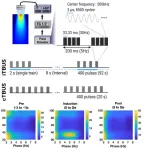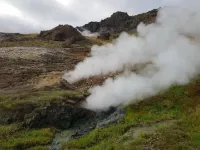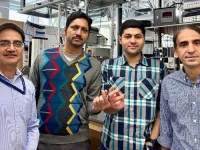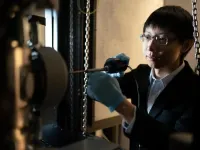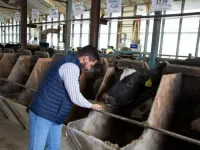(Press-News.org) Understanding cloud patterns in our changing climate is essential to making accurate predictions about their impact on society and nature. Scientists at the Institute of Science and Technology Austria (ISTA) and the Max-Planck-Institute for Meteorology published a new study in the journal Science Advances that uses a high-resolution global climate model to understand how the clustering of clouds and storms impacts rainfall extremes in the tropics. They show that with rising temperatures, the severity of extreme precipitation events increases.
Extreme rainfall is one of the most damaging natural disasters costing human lives and causing billions in damage. Their frequency has been increasing over the last years due to the warming climate. For several decades, scientists have been using computer models of the Earth’s climate to better understand the mechanisms behind these events and to predict future trends. In a new study, now published in the journal Science Advances, a team of researchers from the Institute of Science and Technology Austria (ISTA) and the Max-Planck-Institute for Meteorology (MPI-M) led by ISTA postdoc Jiawei Bao used a new state-of-the-art climate model to study how cloud and storm clustering impacts extreme rainfall events—specifically in the tropics—in more detail than has been possible before.
“This new type of model with a much finer resolution showed that, with a warmer climate, extreme rainfall events in the tropics increase in severity more than was expected from theory due to clouds being more clustered,” Bao, who originally started this project during his previous postdoc position at the MPI-M, explains. “We can see that when clouds are more clustered, it rains for a longer time, so the total amount of rainfall increases. We also found that more extreme rain over high-precipitation areas happens at the cost of expansion of dry areas—a further shift to extreme weather patterns. This is due to how clouds and storms cluster together, which we could now simulate with this new climate model.” This new model, first proposed in 2019, simulates the climate with a much higher resolution than previous ones. Previous models could not factor in clouds and storms in as much detail, therefore missing much of the complex dynamics of air movement that create clouds and make them congregate to form more intense storms.
While the model simulates the whole world at once, the scientists focused their analysis on the area of the tropics around the equator. They did this because cloud and storm formation there works differently than in other latitudes. Caroline Muller, Assistant Professor at ISTA, adds, “Previous models have hinted at the influence of clouds clustering on precipitation extremes but could not provide the necessary data. In collaboration with our colleagues Bjorn Stevens and Lukas Kluft from the Max Planck Institute for Meteorology, our findings add to the growing body of evidence showing that cloud formation on a smaller scale has a crucial impact on the outcomes of climate change.”
Collaborative Models
Researchers all over the world are collaborating on creating more detailed and realistic models of the world’s climate to understand the effects of climate change. Climate models divide the Earth’s atmosphere into three-dimensional chunks, each with its own data about temperature, pressure, humidity, and many more physical properties. They then employ physical equations to simulate how these chunks interact and change over time to create a representation of the real world. As computing power and storage are not unlimited, these models have to introduce simplifications and scientist continuously work to making them more accurate.
Older generations of climate models use chunks of around 100 kilometers in horizontal length, which still result in tens to hundreds of thousands of them covering the whole globe. Advances in algorithms and supercomputers enabled scientists to increase the resolution of the models more and more. “We used a climate model developed at MPI-M and analyzed the data hosted at the German Climate Computing Centre in Hamburg with a resolution of just five kilometers which was very computationally expensive,” Bao adds. “All climate research is an immense collaborative effort by hundreds of people who want to contribute to our understanding of the world and our impact on it.”
Bao, who first got interested in climate research during his PhD at the University of New South Wales, Australia, and who now works as an IST-BRIDGE postdoctoral fellow at ISTA, wants to continue his work on extreme precipitation events to find more evidence for their causes and impacts using additional models.
Caroline Muller, who first studied mathematics and then found her passion for research questions with more real-world impact, and her research group use climate models to study air convection and the formation of clouds and storms at different scales—up to tropical cyclones—to better understand their causes and the impacts of climate change on society and nature.
END
Cloud clustering causes more extreme rain
New climate model shows more extreme rainfall in the tropics with increased temperatures
2024-02-23
ELSE PRESS RELEASES FROM THIS DATE:
Mindfulness at work protects against stress and burnout
2024-02-23
A new study has revealed that employees who are more mindful in the digital workplace are better protected against stress, anxiety and overload.
Researchers from the University of Nottingham’s Schools of Psychology and Medicine analysed survey data from 142 employees. The results have been published today in PLOS ONE.
PhD student Elizabeth Marsh from the School of Psychology led the mixed methods study and said: “As work is increasingly mediated by digital technology we wanted to find out the impact this is having on people’s health and whether there are ways to mitigate this. We found that being mindfully and confidently digital should be considered important elements ...
Scientists closer to solving mysteries of universe after measuring gravity in quantum world
2024-02-23
Scientists are a step closer to unravelling the mysterious forces of the universe after working out how to measure gravity on a microscopic level.
Experts have never fully understood how the force which was discovered by Isaac Newton works in the tiny quantum world.
Even Einstein was baffled by quantum gravity and, in his theory of general relativity, said there is no realistic experiment which could show a quantum version of gravity.
But now physicists at the University of Southampton, working with scientists in Europe, have ...
Revolutionary brain stimulation technique shows promise for treating brain disorders
2024-02-23
The human brain's adaptability to internal and external changes, known as neural plasticity, forms the foundation for understanding cognitive functions like memory and learning, as well as various neurological disorders. New research conducted by a team led by Dr. PARK Joo Min of the Center for Cognition and Sociality within the Institute for Basic Science (IBS) unveils a novel technique that could transform the treatment landscape for brain disorders. The team developed a non-invasive brain stimulation method called Patterned Low-Intensity Low-Frequency Ultrasound (LILFUS), which holds tremendous potential for inducing long-lasting changes ...
Global warming increases the diversity of active soil bacteria
2024-02-23
Warmer soils harbour a greater diversity of active microbes, according to a new study from researchers at the Centre for Microbiology and Environmental Systems Science (CeMESS) at the University of Vienna. The study, published in Science Advances, represents a significant shift in our understanding of how microbial activity in the soil influences the global carbon cycle and possible feedback mechanisms on the climate. Until now, scientists have assumed that higher soil temperatures accelerate the growth of microbes, thus increasing the release of carbon into the atmosphere. However, this increased ...
Patient mindset training helps care teams
2024-02-23
A new study from Stanford University, published Jan. 19 in Patient Education and Counseling, evaluates the effectiveness of patient mindset training on provider learning and behavior.
Past research shows that what patients think, believe, or expect regarding medical care can influence care outcomes. Patients also have better outcomes when they have more adaptive mindsets about their treatments (e.g., “this treatment will be effective”), their bodies (e.g., “my body is capable”), their illnesses (e.g. “diabetes is manageable”), and their care team (e.g., “I am in good hands”). ...
Dual-energy harvesting device could power future wireless medical implants
2024-02-23
UNIVERSITY PARK, Pa. — Implantable biomedical devices — like pacemakers, insulin pumps and neurostimulators — are becoming smaller and utilizing wireless technology, but hurdles remain for powering the next-generation implants. A new wireless charging device developed by Penn State scientists could dramatically improve powering capability for implants while still being safe for our bodies, the researchers said.
The new device can harvest energy from magnetic field and ultrasound sources simultaneously, converting this energy to electricity to power implants, the scientists reported in the journal Energy & Environmental ...
Study: ‘Hexaplex’ vaccine aims to boost flu protection
2024-02-23
BUFFALO, N.Y. – Recombinant protein vaccines, like the Novavax vaccine used to fight COVID-19, offer several advantages over conventional vaccines.
They’re easy to precisely produce. They’re safe, and potentially more effective. And they could require smaller doses.
Because of these traits, there is much interest in developing recombinant influenza vaccines. To date, however, the Food and Drug Administration has approved only one such vaccine.
A University at Bufalo-led research team hopes to add to that number. It is developing a new recombinant flu vaccine – described ...
New structural insights could lead to mechanical enhancement in alloys
2024-02-23
UNIVERSITY PARK, Pa. — A new class of metallic materials with potential applications in airplane turbines, nuclear reactors and equipment for space exploration can withstand extreme temperatures and resist fractures, but scientists haven’t understood why until now. According to a new study co-led by Penn State researchers, the answer could relate to the material’s short-range order, or the local arrangement of atoms within a material. This knowledge could lead to further improvement in the mechanical performance and damage tolerance of these materials, the researchers said, leading in turn to advancements in the safety and reliability of next-generation ...
New research challenges conventional picture of Parkinson's disease
2024-02-23
Parkinson's disease, the second most common type of progressive dementia after Alzheimer's disease, affects nearly 1 million people in the U.S. and an estimated 10 million individuals worldwide. Each year, close to 90,000 new cases of Parkinson’s disease are diagnosed in the U.S.
In a new study, Jeffrey Kordower, director of the ASU-Banner Neurodegenerative Disease Research Center, and his colleagues unveil pivotal insights into the progression of Parkinson's disease, presenting new hope for patients battling the severely debilitating disorder.
The research highlights the role of a critical protein called tau in the early stages of the ...
Dairy cows fed botanicals-supplemented diets use energy more efficiently
2024-02-23
UNIVERSITY PARK, Pa. — Supplementing the feed of high-producing dairy cows with the botanical extract capsicum oleoresin, obtained from chili peppers, or a combination of that extract and clove oil resulted in the animals using feed energy more efficiently and emitting less methane from their largest stomach, according to a new study conducted by Penn State researchers.
Adding those substances, sometimes referred to as essential oils, to the cattle’s rations resulted in improved efficiency of energy utilization in peak-lactation dairy cows. According to Alex Hristov, distinguished professor of dairy nutrition, ...
LAST 30 PRESS RELEASES:
Kennesaw State University’s Jerry Mack named Paul “Bear” Bryant Newcomer Coach of the Year
Ancient teeth are treasure troves of data on Iron Age lifestyles
Avocados may become easier to grow in India—but not if global emissions remain high
Pregnant women with IBD show heightened inflammation in vaginal mucosa
Underwater photos show seabirds, seals and fish interacting with a tidal turbine in Washington State
1 in 5 surveyed UK adults who have experienced the death of a pet report it as more distressing than experienced human deaths, with significant rates of prolonged grief disorder symptoms also being re
Polyester microfibers in soil negatively impact the development of cherry tomato plants in experiments, raising concerns over the potential effect of high levels of such contaminants
LGBTQ+ adults may be around twice as likely to be unemployed or to report workforce non-participation compared to heterosexual adults, per large representative Australian survey
Horses can smell fear: In experiments where horses smelled sweat from scared humans, they reacted to scary and sudden events with increased fear and reduced human interaction
New synaptic formation in adolescence challenges conventional views of brain development
Scientists identify target to treat devastating brain disease
Oliver Zielinski selected as Fellow of The Oceanography Society
Has progress stalled on gender equality at work?
Quantum simulator sheds light on how nature moves energy in systems like photosynthesis and solar conversion
Can a hashtag help prevent atrocities? Study shows social media can be a powerful tool
The American Ornithological Society (AOS) announces the winner of the 2025 Wesley Lanyon Award
Woolly rhino genome recovered from Ice Age wolf stomach
An earthquake on a chip: New tech could make smartphones smaller, faster
New research shows how AI tools are expanding individual capabilities while contracting scientific attention
A nanomaterial flex — MXene electrodes help OLED display technology shine, while bending and stretching
Global research team uncovers mechanism by which metabolites guide cellular decisions
Work hours, stress, and burnout among resident physicians
Quality of life of parents of premature infants
Should younger and older people receive different treatments for the same infection?
Scientists discover how fast the world’s deltas are sinking
Scientists demonstrate first-time use of AI for genetic circuit design
Copenhagen researchers make the front page of Nature: Solving the mystery of the universe's ‘little red dots’
Seoul National University-Drexel University team achieves world's highest efficiency fully stretchable OLEDs with 17% external quantum efficiency
Hydrogel cilia set new standard in microrobotics
Application of orthogonal CNOP-I in a convection-allowing ensemble prediction system based on CMA-MESO for improving extreme precipitation skill
[Press-News.org] Cloud clustering causes more extreme rainNew climate model shows more extreme rainfall in the tropics with increased temperatures




